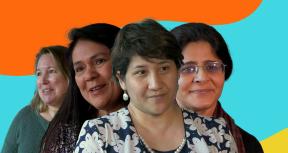The Bank Group’s support to Sub-Saharan Africa declined sharply – dropping nearly 35 percent from previous levels after 2010 in part due to a loss of transport expertise within the Bank Group and shifting client priorities. The drop is significant considering that the region has a massive infrastructure deficit and is experiencing some of the fastest urbanization rates globally.
TWEET THIS
By 2030, sixty percent of the world’s population will live in cities – up from just over 50 percent today. This will require massive investments in infrastructure and support services. Efficient urban transport systems are particularly critical to improving the livability of cities and to driving economic activity. They facilitate the smooth movement of people to and from work, and connect consumers to goods, services and opportunities.
Today, many cities and urban centers are already facing daunting transportation challenges characterized by long commutes, oppressive smog, and frequent gridlock. The consequences are particularly dire for the urban poor. Lack of properly planned transport systems tends to disproportionately disadvantage already marginalized groups, such as women, poor people, and those with disabilities.
Over the past decade (FY07-16), the World Bank Group has invested $25 billion in 297 urban transport projects, according to a recent IEG evaluation of the World Bank Group’s support for Urban Transport, Mobile Metropolises: Urban Transport Matters. The projects covered several areas including urban roads, buses, bus rapid transit, metro, and advisory services and analytics
Among its findings, IEG’s report shows that while the Bank Group has been effective in supporting improved service delivery and increased access in client countries, its support has been uneven across regions.
The Bank Group’s support to Sub-Saharan Africa declined sharply – dropping nearly 35 percent from previous levels after 2010 in part due to a loss of transport expertise within the Bank Group and shifting client priorities. The drop is significant considering that the region has a massive infrastructure deficit and is experiencing some of the fastest urbanization rates globally.
Beyond the size and composition of the Bank Group’s urban transport portfolio, IEG’s report suggests a number of opportunities to enhance the Bank Group’s impact. Specifically, the report identifies four areas – access, demand management, sustainability, and institutional capacity.
Urban transport must be accessible and socially inclusive: Overall, the World Bank Group has been effective in supporting increased supply, access and quality through its projects. However, IEG found that only about 7 percent of the World Bank Group’s transport projects were designed explicitly to meet the special needs of women. Only 10 percent had targeted interventions for the disabled and elderly.
Investing in travel demand management is critical: Increasing supply is only part of the solution when it comes to building efficient transport systems. Improving travel demand management is an essential part of the equation. This means integrated transport and land use planning, adequate regulations and pricing of private vehicular usage, and other traffic management measures. World Bank Group projects that incorporate both travel demand management (avoiding travel and shifting modes) and supply measures were more likely to sustain outcomes than projects that focused on supply.
Sustainability is key: The World Bank Group support to private sector participation in mass transit and other urban transport projects has resulted in greater financial stability in those projects. By contrast, the urban road sector has not attracted private investment, and this has stymied sustainable road maintenance. The World Bank Group can do more to support its clients in this area.
Encouraging the use of public transit, less polluting vehicles, and fuel –efficient transport systems-- is another important component of making urban transport systems sustainable. For the most part, mitigation of motorization effects remains the focus of most World Bank Group interventions, but it should be expanded to include adaptation to the consequences of climate change.
Institutional Capacity: Another challenge is weak institutional capacity in client countries. The World Bank Group has played a key role in enhancing related human resources and management capacity in the sector. Its marquee sectoral training program, Leaders and Urban Transport, has, for example, trained more than 1,000 national and local officials and provided networking opportunities among professionals in the field.
Many World Bank Group interventions have contributed to institutional capacity building by supporting client countries to administer urban transport service provision and strengthen planning. However, the Bank Group has missed opportunities by not undertaking more comprehensive sector-wide engagements designed to build local capabilities and interagency coordination. Instead, many Bank Group interventions were “one-shot” projects restricted to a single local body.
Internally, the Bank Group will need to further strengthen its operations in order to enhance its relevance and contribution to the urban transportation sector. This includes beefing up existing expertise and ensuring better analysis of project financial viability, cost, and timing as well better data collection.
Coordinating better across its public and private sector lending operations will allow Bank Group approach to engage more systematically in client countries and bring a more comprehensive suite of solutions to the table. IEG found, for example, that the work of IFC and MIGA in some cases appears to be disconnected from relevant “upstream” work of the World Bank. Consequently, there may be unrealized investment opportunities involving public-private service provision of urban transport services.









Add new comment